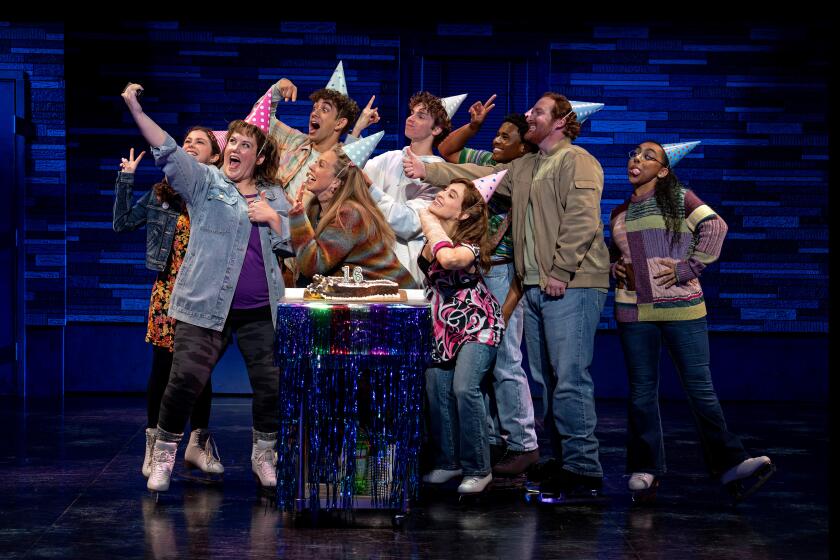Clowning Around With a Cliche
It’s hard to think of a bigger art cliche than clown paintings. But cliches carry a lot of baggage that’s worth inspecting. “Everybody Loves a Clown, Baby, Why Don’t You?” at Chapman University’s Guggenheim Gallery, dares you to find deeper significance in a much-maligned theme.
This is a wild grab bag of a show, filled to bursting with images of red-nosed, white-faced, grinning folks, drawn and painted in their many guises by famous, obscure and hack artists.
A breezy lithograph by Picasso hangs not far from a saccharine painting by Red Skelton. Convicted killer John Wayne Gacy’s self-portrait as a deathly white clown joins the sophisticated imagery of much-praised young artists and a flotilla of softly moody clown faces by commercial painters scorned or ignored by the art world.
There are evil-looking clowns, victimized clowns, goofy clowns, vacant clowns, clowns who surf or scratch themselves or peer down at people engaged in sexual activities.
Also on view are images of Harlequins--oddly wistful folk in diamond-patterned outfits--and assorted characters who wear clown makeup seemingly as a function of their personality rather than their occupation.
Gallery co-director Richard Turner (who borrowed the exhibition title from a Gary Lewis and the Playboys song) admits in a brief written statement that clowns have no “emotional resonance” for him. That’s why he chose to do the show--in hopes of a sudden epiphany. As someone who was similarly “embarrassed and bored” by clowns as a child, I’m certainly empathetic.
Turner’s best move was to commission an essay from artist Jeffrey Vallance. In six mind-bending pages, he discusses the dark and complex historical background of clowns, who are, among other things, throwbacks to the devil characters in medieval morality plays.
Even the seemingly benign clown costume and makeup have a sinister cast. White-face, Vallance writes, “suggests illness or death,” while “the eternally fixed smile . . . recalls the grimace of a bleached skull.” He compares the red nose to “an alcoholic’s diseased schnoz,” and links the sparse hair, oversized shoes and mismatched clothing to the indignities of loss of virility, swollen feet and homelessness.
Add the clown’s typically unbalanced behavior, which, Vallance says, “calls into question all social morality,” and “we must subconsciously know that clowns and devils are part of the same family.”
No wonder, then, that the most memorable clown images tend to be dark. To their credit, the show and many of the artists interpret “clown” in the broadest possible sense, the better to get at the mysteries behind the mask.
The blue-faced creature in an untitled painting by Tim Ebner has a hole where his ear should be, narrow eyes and an open mouth that forms a vacant circle. Part toy, part damaged human, this image is disquieting in its stark emotional numbness.
Christina Hale’s powerful drawing of a clumsy-looking figure of indeterminate race focuses on the curled fingers of his huge hands. Wearing a bicolor outfit with big buttons and a plunger on his head, this individual reveals the coiled tension of being somebody’s fool.
Carole Caroompas used a large clown head punctured by swords as the centerpiece of her elaborate painting, “Fairy Tales: Peter Pan.” In this wry meditation on men who never grow up and regard women either as saints or vixens, the implacably grinning clown seems to represent an inability to register human feelings.
Ben Messick’s image of a clown with emotional, liquid eyes wearing a derby hat and a neat jacket and tie seems to capture the elusive transition between a clown’s professional and private personas. (The lack of label information about dates--and mediums--is regrettable; while many of the artists included are contemporary, Messick was active in the 1930s and ‘40s.)
A moody influence of European Surrealism creeps into several of the paintings by clown specialists, including an untitled scene by one J. Raito in which a girl wearing a Harlequin headdress holds a bird against a backdrop of spidery fairground architecture.
Not everything of note in the show is deadly serious.
William Anthony’s “Harlequin”--a morose couple sitting side-by-side near a glass of green liquid--is a takeoff on Picasso’s famous Blue Period painting of poor circus folk. Translated into the contemporary artist’s cartoon-like figures with steep foreheads and splayed fingers, the melancholy of the original mutates into a drolly pathetic charm.
Vallance’s faux relic, “The Clowns of Turin”--a series of goofy faces with peculiar pink and purple markings--builds on the mystique of the Shroud of Turin, believed by some to be Jesus’ burial cloth. When the devil tried to destroy the cloth, Vallance deadpans, he made burn marks that look like clown faces.
Disruptive Images
*
Upstairs, in the gallery’s newly dubbed Project Room, the walls are filled with Miriam Dym’s computer-generated “New Planning Part 2: Disrupting Maps.”
All you see are baffling clusters of arrows, diagrams suggestive of athletic court markings or flow charts or dress patterns, meandering pathways, random numbers and arbitrary lists of words.
One segment of this futuristic-looking spew of laser prints--a pattern of pink and orange lines on a pale green background--is oddly reminiscent of early-’60s fabrics. But the overall effect of the piece is a constant short circuit, as you try and fail to puzzle out what it all means.
That’s precisely the point. Dym’s laser prints resemble the graphic devices that are supposed to make our lives run more smoothly--except that her images leave out all the content.
The frantic, multilayered quality of these designs evokes the bafflement we often feel in an age of increasing complexity and specialization. The more tools we have to stay in touch with the world, the less able we are to keep up with the flow of information.
Fellow artist Adam Ross has more to say about Dym’s piece in a fine essay, available in a free booklet. Commissioning literate artists to write about art is a great idea, another reason the Guggenheim remains a key venue in Orange County for new ideas about art.
*
* “Everybody Loves a Clown, Baby, Why Don’t You?” (through Oct. 16), and Miriam Dym’s “New Planning Part 2: Disrupting Maps” (through Oct. 2), at Guggenheim Gallery, Chapman University, 333 N. Glassell St., Orange. Free. Hours: noon-5 p.m., Monday-Friday; 11 a.m.-4 p.m. Saturday. (714) 997-6729.
More to Read
The biggest entertainment stories
Get our big stories about Hollywood, film, television, music, arts, culture and more right in your inbox as soon as they publish.
You may occasionally receive promotional content from the Los Angeles Times.










